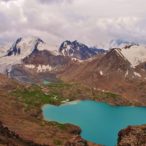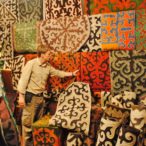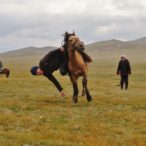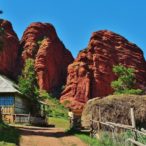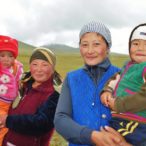Kyrgyzstan
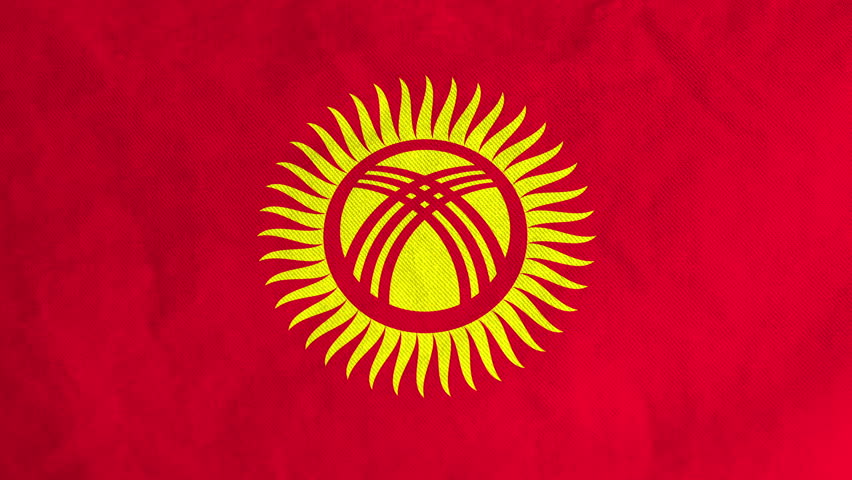
Official name: The Kyrgyz Republic
Population: 6 100 000
Area: 198 500 km²
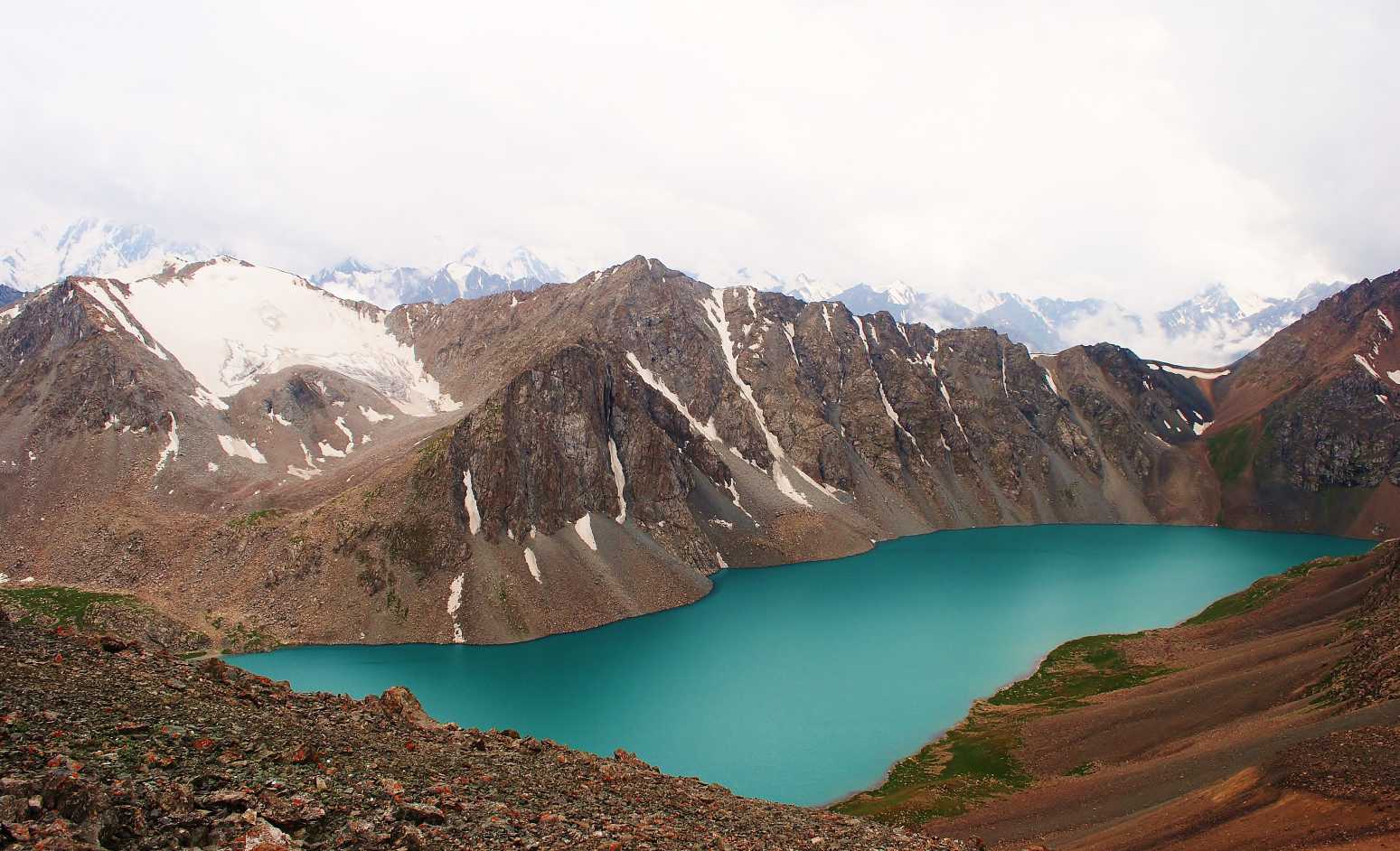
Gallery
Tourist attractions of Kyrgyzstan, Kyrgyzstan – the present times, brief history of Kyrgyzstan.
Tourist attractions of Kyrgyzstan
Kyrgyzstan is a country of great natural beauty, and travelling around it gives an opportunity of discovering breathtaking and wonderful landscapes. In Kyrgyzstan we can understand that nature creates art in a full meaning of this word. In a country where 94% of its area is covered by mountains, alpine expeditions on every level are highly popular. Kyrgyzstan is the kingdom of Tien-Shan, turquoise lakes, glaciers and hidden treasures in the mountains. Peak Pobedy (7439m above sea level) is the highest summit, which is also a natural border with China. Getting there is not only for the ambitious ones but also for the rich, because preparation, equipment and guide are needed. I think that to get to know the natural beauty of Kyrgyzstan I recommend the following places: a trip to Altyn Arashan and from there a horse expedition to the turquoise lake of Ala-Köl, expedition to the alpine lake of Issyk-Köl which is a national pride of Kyrgyzstan, walnut forests and waterfalls around Arslanbob, visiting birds of prey breeders, Karakol Valley and many other horse trips into the mountains.
There are many possibilities because Kyrgyzstan is such a beautiful country, that even driving a car and looking out of the window guarantees natural beauty. I want to make it clear however, that we can`t expect luxury on any of those trips, by which I mean for example good transportation or any transportation at all. Sometimes I had to walk many kilometers, looking at the mountains and sheep grazing on green pastures, but these are the tourist attractions of Kyrgyzstan. There are also hot springs in Kyrgyzstan, and it is mandatory to swim in an icy river afterwords. I also recommend a visit by Song-Köl lake, where festivals of Kyrgyz culture are sometimes held, and which mean horse racing and wrestling on horses. When you`re close to Karakol I also recommend a visit in Jeti-Öghüz where we can see red sand stones in a shape of broken heart. In towns of Naryn and Kochkor I recommend buying a shyrdak, which is a national carpet made of goat`s wool. Also, drinking kumyz (fermented milk from mares) and eating shashlyks with onion only adds flavour to our Kyrgyz adventure.
Kyrgyz people themselves are attached to their warrior culture, which today is reflected among other things in the national sports of Kyrgyzstan, although football is increasingly popular.
Traveling around Kyrgyzstan is a hard work which gives satisfaction to the strong and persistent travellers. I have done all the above things and many others and I consider Kyrgyzstan to be a country of beautiful landscapes and wonderful adventures. Everyone who comes to Kyrgyzstan will be fighting with charms of its natural beauty and although it is not always easy I highly recommend this country.

Altyn Araszan and a horseback riding trip to the turquoise Ala-Köl lake. Kyrgyzstan.
Kyrgyzstan – the present times
Introduction:
In April 2010 (just before my visit) there was a bloody revolution on the streets of Bishkek, during which President Kurmanbek Bakiyev was forced to resign and to flee the country. A few months later there was another violent incident. In the cities of the Fergana Valley an ethnic conflict broke out, and the victims were Uzbeks living in Kyrgyzstan. (I was in the cities of Osh and Jalal-Abad after it happened. More about it in my report). An interesting fact is also that this small and poor central-Asian country is an important strategic point, and there are U.S. and Russian military bases.
Economy:
Since the independence there have been a lot of economic and financial reforms legislatures in Kyrgyzstan. However, because of great corruption Kirgiz people are still poor, and political and economic uncertainty are part of everyday life. Kyrgyzstan was the second poorest country of the Soviet Union, and today it is the second poorest country of Central Asia. This means that about 30% of people in Kyrgyzstan live below the poverty level. From what I learned the average wage is still only $50 per month, although many do not earn at all. Police for example feels unpunishable and they see tourists only as an extra income. After collapse of the Soviet Union, the economic situation was so bad, that in 1991 almost 90% of the electorate voted for coming back to the Soviet Union, if it was a possible. Many factories and basic industries ceased to exist with the breakup of the Soviet Union. The economic situation in Kyrgyzstan has recently improved very slightly, because 800,000 Kyrgyz citizens work in Russia, what makes up about 40% of GDP of Kyrgyzstan. This proves that the situation is even more tragic, but on the other hand the standard of living in Kyrgyzstan is still better than in India.
The main branch of industry is agriculture, which employs about 35% of people. Kyrgyzstan is a mountainous country with green valleys, what helps to keep livestock for meat, wool and milk. These are mainly horses, sheep and goats, and so often camels. Crops are mainly: wheat, various vegetables, fruit and tobacco. Kyrgyzstan is also particularly known as an exporter of walnut, from Arslanbob. Unfortunately, petrol and agricultural machines are so expensive that Kyrgyz people still farm the land manually and by using animals, as it was many decades ago. Kyrgyzstan is rich in natural resources, and therefore metallurgy is an important part of the Kyrgyz industry. Kyrgyzstan also has deposits of coal, gold and uranium. On the other hand however, the government is trying to encourage foreign investors to the industry of mining and gold processing, because they do not have the money themselves. Kyrgyzstan’s terrain also gives very good opportunity for production and export of hydroelectric power. To date however, many rural farms depend only on what they grow, and rural and urban economies are very different from each other.
Infrastructure in Kyrgyzstan does exist, but unfortunately it is not good. There is only one line of rail tracks, and besides Kyrgyzstan depends on serpentine roads winding around the mountains, where there is a risk of avalanches. That`s why for example horse transport is still very popular, what has cultural background and saves money on petrol.
Education:
Education in Kyrgyzstan is compulsory and free for 9 years., from 7 to 15 years of age. However, this means that the school enrollment rate is only about 85% -90%. In primary or secondary schools all subjects are taught in Kyrgyz, but at universities it is Russian . Kyrgyz government spends on education about 4.5% of its GDP, which is reflected in low salaries of teachers and lack of proper equipment. The official language is Kyrgyz and still Russian, although nobody knows how long. Literacy level stands at 99.5%.

The mountain lake of Issyk-Köl is the national pride of Kyrgyzstan.
Health:
Healthcare in Kyrgyzstan is modeled on the Soviet Union, what means that thereare enough hospitals and enough doctors per citizen, but there is a huge disparity on the distribution of hospitals, lack of equipment and poorly trained staff. The worst situation is that the south, around Osh and Jalal-Abad, where there aren’t enough hospitals, equipment or staff. The big problem in Kyrgyzstan is also in a very poor state of economy and low wages, which has deteriorated significantly since the collapse of the Soviet Union. It leads to the fact that many doctors choose other professions. Apart from that problem Kyrgyzstan does not produce any drugs or vaccines, what means that it has to import everything and pay in U.S. dollars, which Kyrgyzstan simply doesn’t have. Due to the lack of basic vaccines, there is a high risk of outbreaks of diphtheria and measles, as it already took place in 1993. Health care is so bad that patients have to buy their own medicines and even operation tools. The quality of those tools bought in bazaars is very bad and poisonings is weak have already occurred due to lack of hygiene.
Infant mortality is about 70 per 1,000 births. The most common disease is tuberculosis, and unfortunately HIV, which happens most often in prisons, and in the south of the country because of drug smuggling and drug use. In addition, because of the very poor hospital care there was a case of 72 children who got infected with HIV in hospitals, and then those children passed HIV to their mothers. Kyrgyz health system is under constant change and looking for investors.
Culture/Religion:
Out of the 5 million of Kyrgyzstan`s population 52% of Kyrgyzstan are Kyrgyz, 10% are Slavs, 14.5% are Uzbeks, and others. Islam in Kyrgyzstan (91%) is only a cultural tradition and does not run people’s lives, as it is in the extreme Islamic countries. Christianity (17%) is mainly professed by Russians and Ukrainians, but also Germans, who did not return to Germany after the collapse of the Soviet Union. Kyrgyz culture is based primarily on the nomadic way of life, what means that shepherds on horseback roam great distances in search of new pastures for their animals. Kirgiz culture is also associated with the traditional yurts, drinking fermented mares milk and green tea, transportation of equipment and tents on the backs of horses and camels.
Kyrgyz people also produce their national clothes and traditional goat woolen carpets called shyrdaks. Women specialize in manufacturing of textiles who make clothes and carpets with very elaborate designs. According to the tradition, the carpet and rags are hung in the Kyrgyz yurt and are a pride of married couples. Today however, shyrdaks are also produced for tourist and it generates big business. Kyrgyz cuisine is a reflection of Kyrgyz nomadic lifestyle, and it`s made up of mutton and lamb, but also milk and cheese from those animals. There is also “plov” with rice drowning in oil with some meat, which is a popular dish in all the countries of Central Asia. The nomadic lifestyle is also reflected by the national games of Kyrgyzstan, which I described here. In addition, in Kyrgyzstan there is also an illegal but still practiced custom of kidnapping brides. Generally it does not bring the desired results, but from time to time there are happy marriages. Kyrgyzstan has a mythical epic hero called Manas, and Kyrgyzstan`s flag represents sun seen from the inside of the yurt.
Media:
In a country of so many quick political changes, revolutions and even an ethnic cleansing, it is hard to maintain freedom of the press. In Kyrgyzstan only in 2011 there were recorded three attacks on journalists and the media did not report important information about the murders of policemen and Uzbeks. However after the overthrow of President Bakiev the situation has improved. On the press freedom list out of 179 countries and territories, in 2011-2012 Kyrgyzstan was on 108th place, which is a huge improvement comparing to 2010 when Kyrgyzstan was on 159th position.

My horse during a mountain expedition through Kyrgyzstan.My horse during a mountain expedition through Kyrgyzstan.
Environmental problems:
Problems associated with environmental pollution, are mainly air pollution due to excessive emission of carbon dioxide into the atmosphere, but also global warming and desertification areas. Another problem is in too many of non-native species what puts the native species in a difficult situation. In addition, there is also an over-cultivation and deliberate animal killing. Also the mining industry which is located at high altitudes, pollutes with toxic and radioactive wastes and heavy metals. This is obviously a big problem for high-altitude ecosystems, but at the same time municipal wastes are also of great concern, because they are not recycled in an appropriate way.
Brief history of Kyrgyzstan
Kyrgyz culture has its origins around 200 BC and is a people are of Turkish origin, who then lived in the area of ??today’s Mongolia. Then, the nomadic people travelled to the area of ??today’s Siberia and occupied it to about VIII century. However, when the Mongol Empire grew in strength, Kyrgyz people moved south. It is also worth saying that in the XII century Islam was the leading religion in this region. It was not until about the XVI century when Kyrgyz people started occupying the area, which now we know as the Republic of Kyrgyzstan. But this did not mean a trouble-free future, because in 1876 the Kyrgyz Republic became a part of the Russian Empire. This caused a strong opposition against tsar, and as a result many Kyrgyz citizens emigrated to China.
Then from 1918 until 1926 Kyrgyzstan had many names within the tsarist state, and it was not immediately recognized as a separate nation from Kazakhstan. In those years, one of the names was the Kyrgyz Autonomous Soviet Socialist Republic. For example in 1936, within the Soviet Union was formed the Kyrgyz Soviet Socialist Republic and that name existed until the collapse of the USSR. Even though Kyrgyzstan was under occupation, in the late 20s of the XX century they developed art, culture, economics and education, but unfortunately the alphabet was changed too many times. For example, first was the Arabic alphabet, then Latin and finally Cyrillic, which is in force today. In the 80’s it was still not allowed to form political parties but there was greater freedom in promotion of Kyrgyz literature.
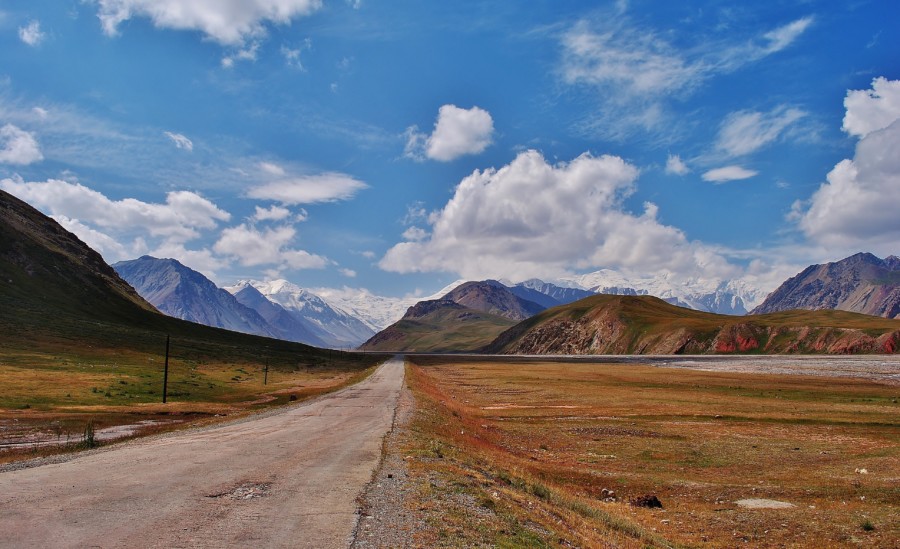
The Pamir Highway shared with Tajikistan. Kyrgyzstan.
I think that the most important year was 1991, when together with the collapse of the Soviet Union the independent Republic of Kyrgyzstan was finally created. During that time also the name of the capital city was changed from Frunze to Bishkek. Despite the independence, the country’s economic condition was so poor that in 1991 nearly 90% of voters voted for resumption of the USSR, if this was possible.
Travel reports
Map
Location
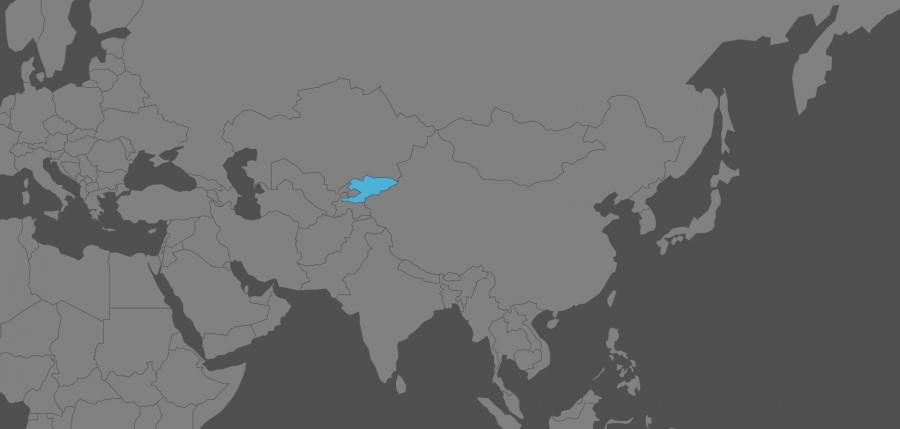
Practical information
Tourist visa: Kyrgyzstan is another country of Central Asia that has abolished visas for British, Poles and most Europeans, provided that the stay does not exceed 60 days.
However, I would like to say what problem I had in 201o. I paid for my Kyrgyz visa in London, which was a big mistake because it was expensive. For a multiple-entry one month visa I paid £60. I had to provide a photo, fill out the form and after few days the visa was ready. Visa for Kyrgyzstan is the easiest out of all the Central Asian visas. The official invitation was not needed. Registration in OVIR (immigration police) on a tourist visa for 90 days was needed, but not for a maximum of 30 days stay.
Safety: First of all I want to stress that I crossed Kyrgyzstan just after the ethnic cleansing in the Fergana Valley. To my surprise it was always very safe and I never had any problems, although the over-sensitive British press wrote false horrors about Kyrgyzstan. This applies to both, the area around Bishkek and Issyk-Köl, and central and southern parts of the country. When I hit the rubble covered Osh and Jalal-Abad I also had no problems. My advice is to just stay away from “dirty cops” who always look for a reason to give them bribes, and of course you must be sensible whith regard to mountain explorations and lonely trips to remote areas.
Moving around the country: In the northern part of the country there is no problem with transport. I particularly recommend small buses (marshrutkas). As for driving between Bishkek-Osh, when I was there, the only possible way of transport were shared taxis. In the mountains you will have to walk many kilometres or rent a horse or possibly a donkey. Another excellent way of transportation is hitchhiking, which I got used to so much that I didn’t bother to stop buses.
Prices: (in 2010 when £1 = 75KGS) Kyrgyzstan is cheap but you should bargain because the prices are more expensive for tourists. I also noticed that I saved a lot of money by speaking broken Russian and by having a Polish passport. I think that $20 a day is sufficient but you can easily spend more. The most expensive thing are shared taxis and accommodation in Bishkek. Food and Internet are cheap.
Climate: for such a small country, Kyrgyzstan’s climate is very diverse. In some regions there is continental climate and in another part similar to the sea climate. This happens because of the huge Issyk-Köl lake and the surrounding mountains. In the greatest area of Kyrgyzstan, there is a temperate climate and subtropical in the south. Around the lake Issyk-Köl, there are numerous winds and temperature is around -4oC to -9oC in winter and 20oC to 27ºC in summer. In areas of high altitude air temperature drops down to -50°C, and the highest annual temperature of 43oC is in southern Kyrgyzstan.



